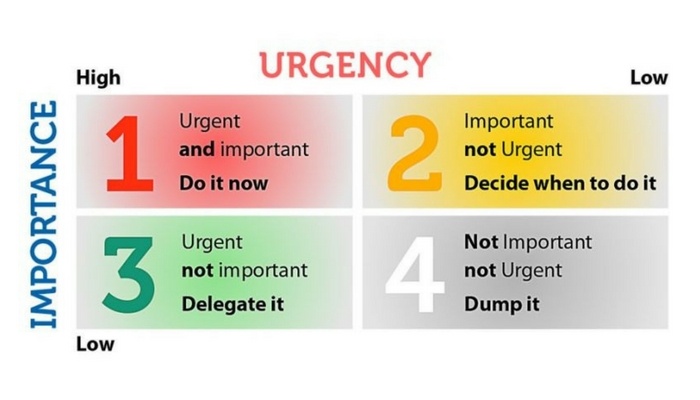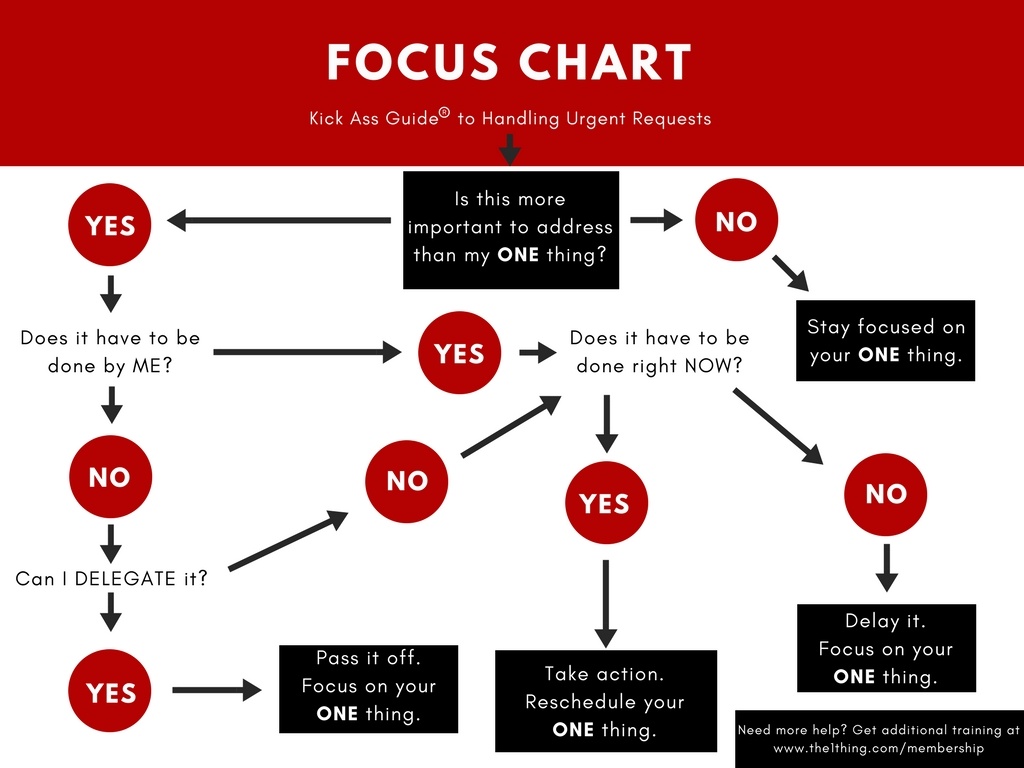Big lives are messy – that’s just a fact. Between our personal and professional endeavors, we each have an ever increasing number of responsibilities that require our attention. With so much of our lives consumed by family and work, it can seem nearly impossible to have it all. But it isn’t. Like anything, having a business and a family life can be done – it just requires a little work.
The first thing we have to get out of the way is the idea of a Like we say in The ONE Thing, when we try to “attend to all things, everything gets shortchanged”.
Success happens at extremes, by giving something its unequal share of time, we give ourselves an unequal chance at extraordinary success. When we succeed in one area, we go to the extreme in another and do the same thing. Ping-ponging back and forth creates a counterbalanced life that actually feels like balance.
Counterbalancing and investing an unequal amount of time into something doesn’t mean forsaking everything else. Unequal doesn’t mean all. It just means that our priority is reflected by the way we use our time. At the end of the day something’s got to give. By taking command of our time and dedicating ourselves to our priority, we can counterbalance our family and business lives and effectively achieve extraordinary results in both.
Finding Out What Matters Most
Counterbalancing requires us to know what matters most. If you haven’t figured out your ONE Thing already for your family and business lives, apply the Focusing Question to them:
“What’s the ONE Thing I can do such that by doing it everything else will be easier or unnecessary?”
The Focusing Question leads us to our ONE Thing, and when you apply it to two areas of your life, you’ll likely find that you’ll have two things (one for each) that take priority and will be your aim for counterbalance. Think of your ONE Thing like a compass that points you toward true north. Without it, you’ll have a hard time getting anywhere. If you’re having trouble at arriving at an answer, don’t worry. Check out one of our previous posts on the subject that will help guide you.
When you know what matters most, you’ll then have to start treating it like it matters the most. That means figuring out which one to counterbalance first.
Setting Your Priority
The idea of having more than ONE Thing might confuse those who haven’t read our book. But there are at least seven areas of your life that each have their own priority—your business and family life included. In order to counterbalance, we need to set our priority.
Everything doesn’t matter equally. Knowing what requires our unequal share of time at any given moment is a key part of achieving extraordinary results. With our ONE Things in mind, we know what needs to be done, but we also need to weigh their importance and urgency. That’s where the Eisenhower Matrix works wonders.

In 1954, President Dwight D. Eisenhower gave an address where he referred to a former college president who once said, “I have two kinds of problems, the urgent and the important. The urgent are not important and the important are never urgent.” From there, the Eisenhower Matrix was born.
What the matrix does is help us prioritize our demands. The most immediate and important demands go in boxes 1 and 2. They’re the things we need to do right now or in the near future. Demands that go in boxes 3 and 4 can either be pushed till later, delegated, or completely ignored. Using the matrix helps us quickly figure out what things are actually in our 20 percent – and which are in our 80 percent.
Investing an Unequal Share of Time
With your priority in mind, it’s time to invest an unequal share of time into your ONE Thing—and that means TIMEBLOCKING.
We talk a lot about the importance of timeblocking here at The ONE Thing, and that’s for good reason. It’s the key to managing our time in a way that is accountable for productivity. When it comes to counterbalancing, productivity is essential. We can’t afford to waste precious minutes when two things are beckoning for our attention.
By incorporating timeblocking into your strategy you’ll be more efficient with your time by using it more effectively. When we reserve our most productive hours for our most important tasks, we give ourselves the best possible chance of using our time to its full advantage. We can either spend a few hours of uninterrupted focus working on something and doing it well, or we can spend countless distracted hours doing something and hoping it’s done well.
For those who don’t know how to timeblock, it’s simple.
Start By Timeblocking a Vacation
The first thing you need to time block is your vacation for the year. It’s a clear win for both your business and family life. Not only do you give yourself the opportunity to rest and recharge so you can tackle your work with vigor, it also gives you a chance to create lasting memories with your family.
One of the biggest reasons why it’s the first thing you timeblock is because if you don’t jump out on it early, you may never get around to doing it at all. In 2016, 54 percent of American employees didn’t use all (or any) of their vacation time. That’s atrocious! We need to rest and reset every once and a while — our health and productivity depends on it. Vacations are proven to reduce stress level and curb burnout, two problems that can lead to a number of health complications.
Planning ahead for vacation also gives us the ability to be strategic and use it when we need it the most. If you know that your business life gets stressful during a few certain weeks of the year, then you can jump ahead and schedule a vacation following those weeks to give you a chance to recoup.
Next, Timeblock Your ONE Thing
Next, move on and block off time for the ONE Thing that matters most for either your Family or Business life.
If you haven’t already, break down your ONE Thing into individual goals or tasks that, when completed, will move you toward achievement. To do that, take full advantage of our Kick Ass Guide to Goal Setting. This simple guide will take your ONE Thing and walk you through the dominos you need to set up and knock down in order to succeed. These little steps lead to big outcomes and are what you’ll be focusing on during your timeblock.
Once you’ve timeblocked your ONE Thing, you’ll need to hold yourself accountable. Whatever we measure improves. Start tracking your progress by maintaining a 411 and creating a GPS. These tools allow you to keep tabs on both your personal and professional goals from a top down perspective. It also serves as an outline for the annual, monthly, and weekly goals you set earlier.
Lastly, Timeblock Your Planning Time
Things happen. That’s why timeblocking isn’t a “set it and forget it” activity. After you’ve timeblocked your ONE Thing once, you’ll find out just how many things in your life are competing for your time. You’ll likely realize that in order to succeed, you’ll need to continue a habit of timeblocking regularly, and that actually means timeblocking the time you need to timeblock. (Super meta, right?)
Set aside some time each week to go over your 411 and to run your tasks through the Eisenhower Matrix again. If urgent and important issues arise in your family or business life, adjust your timeblocks accordingly. If you’re struggling with something else vying for your time, consult our focusing chart for your options:

Remember to always stay dedicated to counterbalancing for your ONE Thing. You’ll know you’re doing it right when you look at your weekly calendar and can see just how much more time you’re dedicating to your priority than to everything else.
At the end of the year, it’s a good idea to timeblock a giant planning session to assess where you failed, where you succeeded, and plan for any major adjustments you need to make for the following year. Think of it as a productivity “checkup”.
Creating Boundaries and Expectations
Timeblocks can help us create a set of boundaries around our work. When we set up a timeblock, we are creating a specific safe space for us to do our best work. Without creating time for us to focus on our one thing, it’s easy for our time to get hijacked. By creating a solid line between our ONE thing and everything else, we can help prevent people from stealing our time.
A recent study of working professionals found that it was incredibly important for employees to set up boundaries around their time in their calendars. In the study, professionals in the Boston and Detroit area were interviewed about their shared calendar use at work. Through a process of interviews, the researchers were able to conclude that shared calendars at work could create problems. When we don’t block our time, people who share our calendar might assume that time is free – and try to take it. evels of stress and job dissatisfaction.
Sometimes when we’ve created our timeblocks, our boundaries can still get crossed because successful timeblocking can also rely on other people’s buy-in. Creating boundaries around your timeblocks can be hard. Harder still to set when you’ve never explicitly done so before. If you feel like you’re struggling, take some time to write out your honest expectations for yourself and your coworkers/friends/partners. Make sure you let people know what you expect of them, and what they can expect from you. If you feel like people aren’t respecting your timeblocks, make sure to tell them in an honest, respectful way. Communication is the key to successfully managing your boundaries – without it, you aren’t going to protect the focus you desperately need.
Leverage Help to Handle the Chaos
The greatest challenge we face when counterbalancing our business and family lives is the chaos that ensues when we make commitment to our ONE Thing. You’ll feel a lot of pressure to simply have more time, and as we covered—you only have so much. But there is one caveat, you can use your money and key relationships to leverage the time other people and technology. Successful counterbalance between your family and work doesn’t happen without leverage.
Delegate
Delegating out tasks helps frees up your time, as well. Which, in turn, gives you more opportunities to spend time counterbalancing our family and businesses.
In business, that means hiring extraordinary talent to drive your business and help you succeed. It’s why the first hire of many successful entrepreneurs is an assistant. When you hire an assistant, you double your available time because they handle everything that you can’t. It doesn’t matter if they’re virtual or personal, whether they’re part time or fulltime—if they give you back the time you need to focus on your 20 percent, they’re probably worth it.
Hiring help at home is just as important. While it can be easy to fall into the trap of thinking we need to do everything ourselves, there’s nothing wrong with outsourcing jobs at home. Whether you’re a parent of five or a parent of pets, there are always ways to streamline our life and take things off our plate. A great resource can be websites like Task Rabbit. Task Rabbit helps match up users with people to accomplish particular tasks. That way, instead of spending all of your time raking up the leaves, you can match up with a tasker who will do it for you.
All of this comes back to the idea of priority. You may even find that leverage is your priority. If you can’t focus on your ONE Thing because you have too many urgent things pressing for your attention, your ONE Thing right now might be finding someone you can delegate to!
Automate
Technology also offers us a series of resources for getting things done faster and easier. From scheduling to vacation planning, there are now a number of great apps that help take over the drudgery of the 80 percent. That way we can focus on the things in our lives that really matter.
If you’re in need of an assistant without wanting to hire an actual person, there are a number of AI based assistants, like x.ai, that can manage all your scheduling needs. Or, if you need an interactive to-do list that helps keep you on top of things, apps like Remember the Milk or Wunderlist are great options. Chore Monster is a great way to get the kids excited about chores – it turns them into a game. That way, you don’t have to waste hour trying to convince your eight year old to tidy up their bedroom. There are also some great apps, like Handy, that connects you with trained professionals that can help you with anything from painting walls to cleaning up the garage.
The list could go on – but you get the idea. In the digital age, there’s a number of incredible sources to draw from in order to help you delegate tasks.
At the end of the day, the key to counterbalancing is understanding how to prioritize, properly using the resources you’ve been given, and finding ways to leverage more time. From people to time, everything we use on a daily basis requires thought and planning. It just takes a little thought and some elbow grease.
Still struggling? Try our Time Blocking Mastery training! What’re your counterbalance habits? Let us know on our Facebook page.

